Business in Practice 1: Organizational Analysis Report
VerifiedAdded on 2023/01/04
|10
|2677
|73
Report
AI Summary
This report provides a comprehensive overview of different types of business organizations, including micro, small, medium, and large businesses, as well as various legal structures such as sole traders, partnerships, limited liability companies, and cooperatives. It explores different organizational structures like hierarchical, matrix, flat, and divisional structures, and analyzes how these structures impact business productivity. The report also delves into the PESTLE analysis, examining the influence of political, economic, social, technological, environmental, and legal factors on a business's performance. The report highlights the characteristics of each type of organization, their operational methods, and the external elements that affect their success, providing valuable insights into business management and strategic planning.
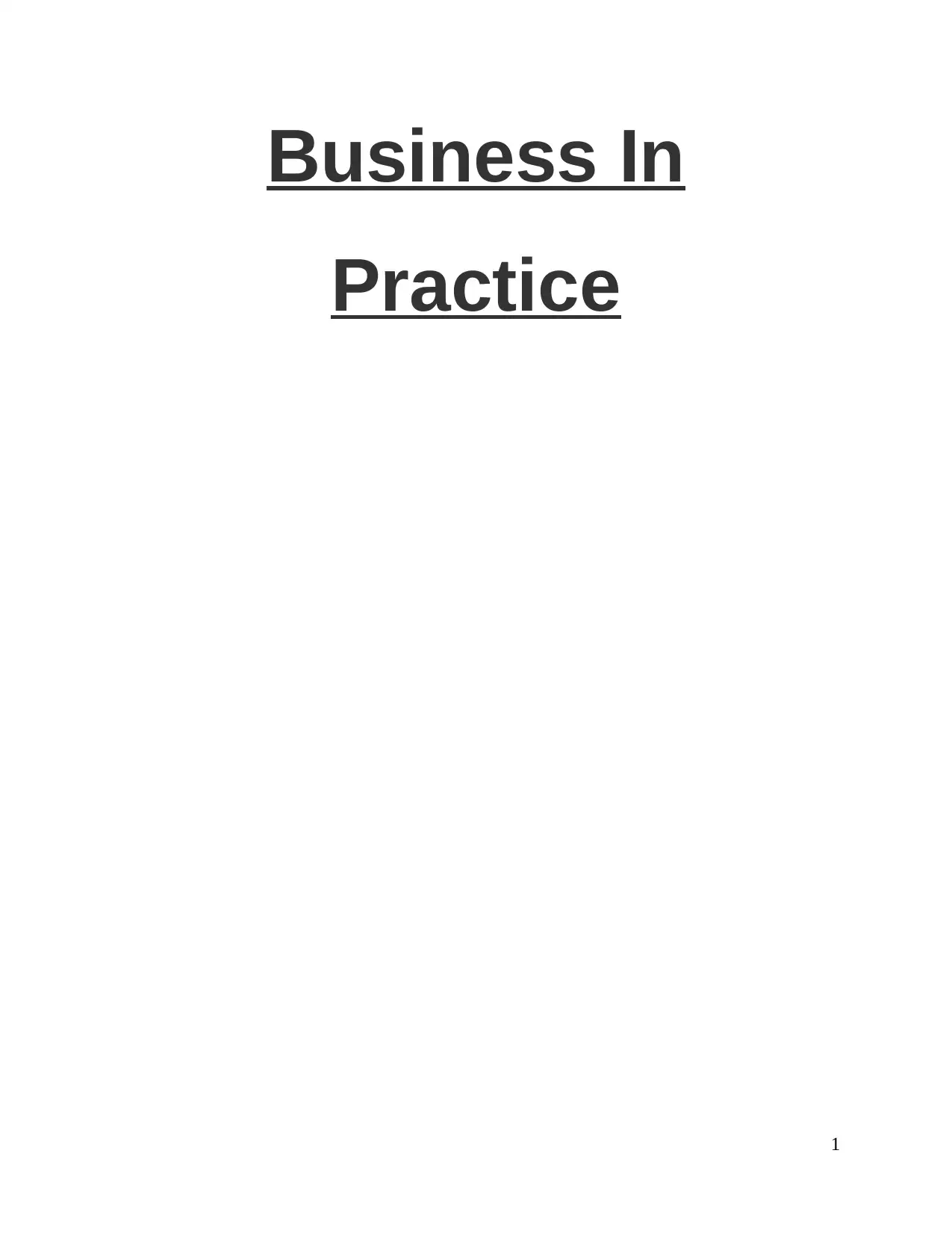
Business In
Practice
1
Practice
1
Paraphrase This Document
Need a fresh take? Get an instant paraphrase of this document with our AI Paraphraser
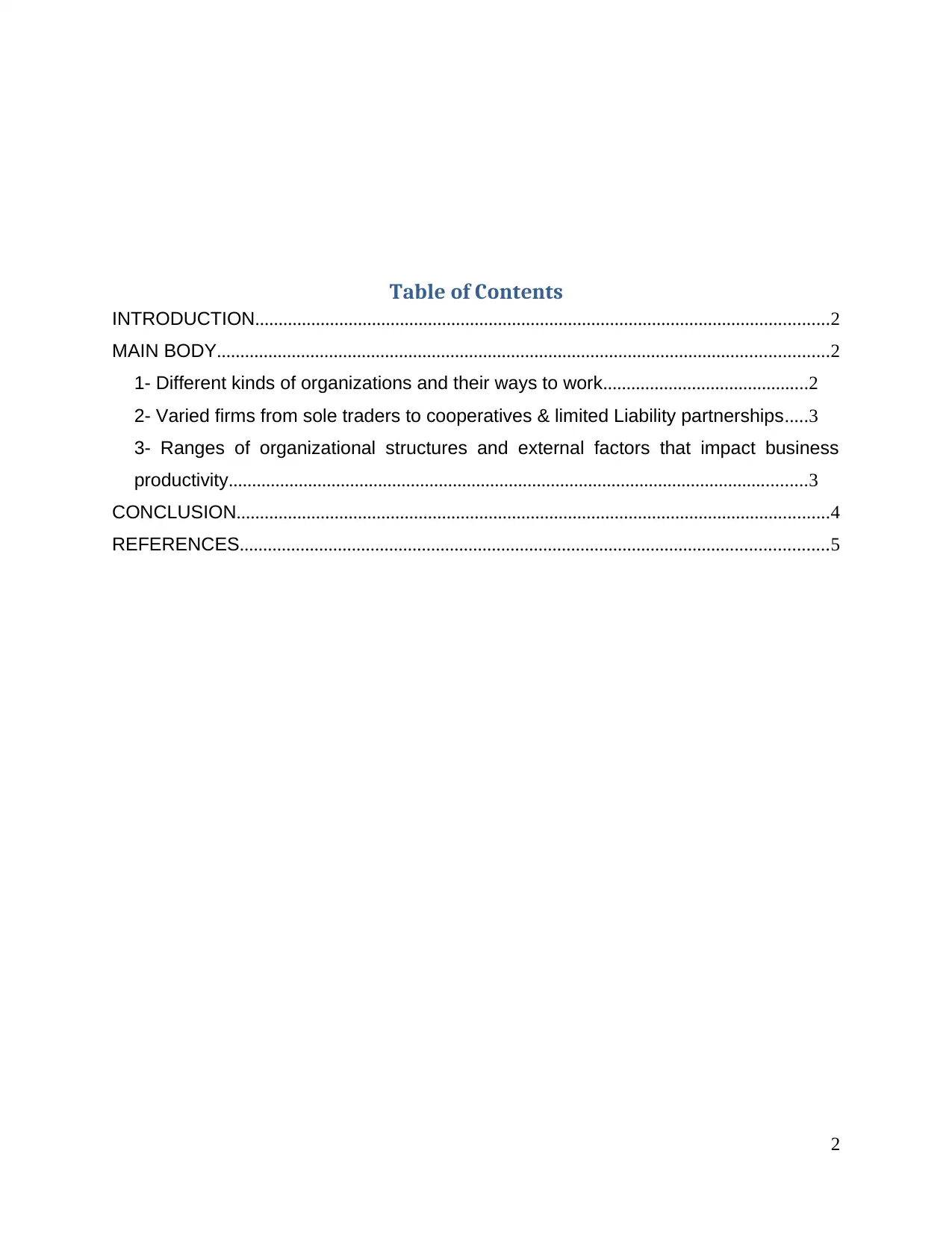
Table of Contents
INTRODUCTION...........................................................................................................................2
MAIN BODY...................................................................................................................................2
1- Different kinds of organizations and their ways to work............................................2
2- Varied firms from sole traders to cooperatives & limited Liability partnerships.....3
3- Ranges of organizational structures and external factors that impact business
productivity............................................................................................................................3
CONCLUSION...............................................................................................................................4
REFERENCES..............................................................................................................................5
2
INTRODUCTION...........................................................................................................................2
MAIN BODY...................................................................................................................................2
1- Different kinds of organizations and their ways to work............................................2
2- Varied firms from sole traders to cooperatives & limited Liability partnerships.....3
3- Ranges of organizational structures and external factors that impact business
productivity............................................................................................................................3
CONCLUSION...............................................................................................................................4
REFERENCES..............................................................................................................................5
2
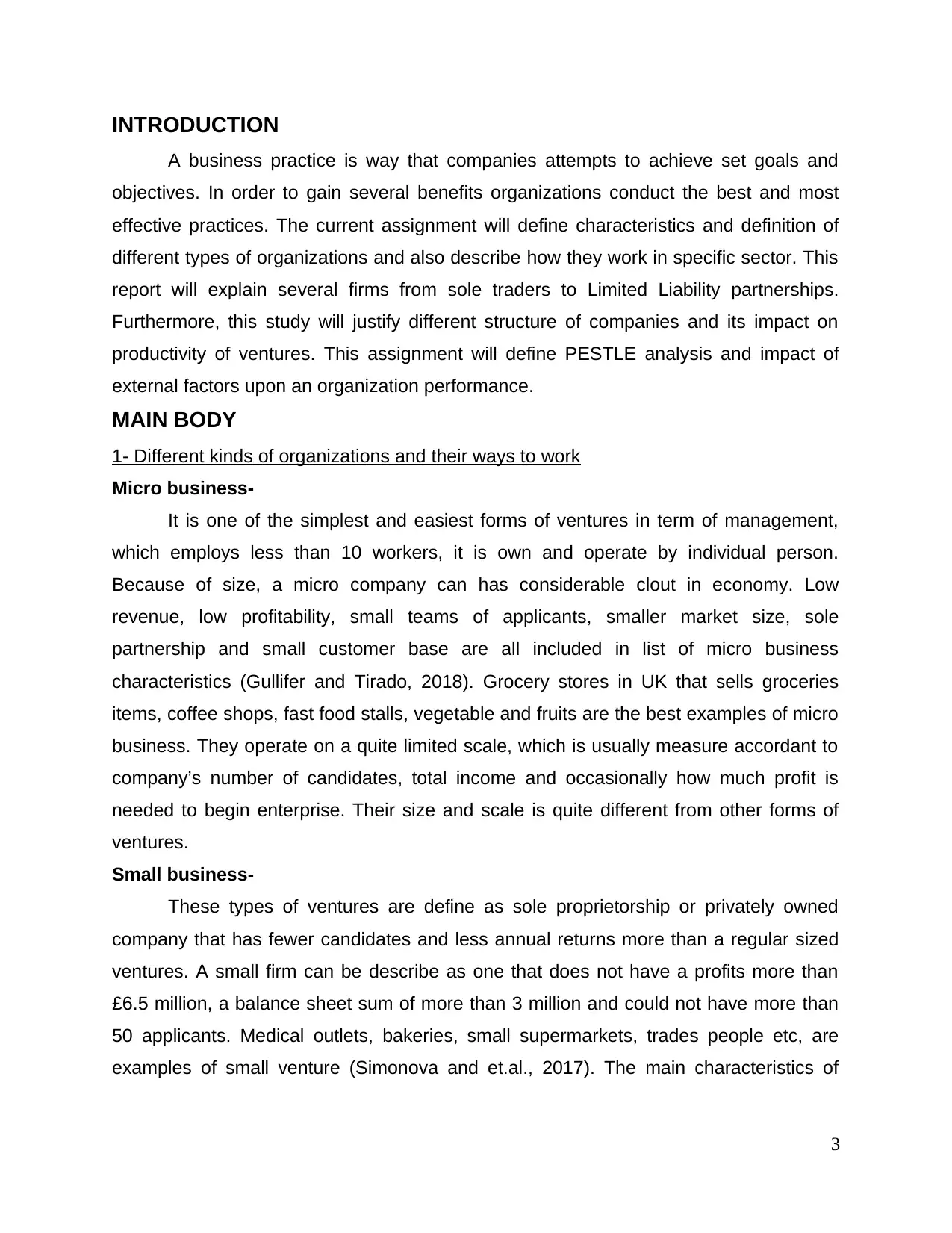
INTRODUCTION
A business practice is way that companies attempts to achieve set goals and
objectives. In order to gain several benefits organizations conduct the best and most
effective practices. The current assignment will define characteristics and definition of
different types of organizations and also describe how they work in specific sector. This
report will explain several firms from sole traders to Limited Liability partnerships.
Furthermore, this study will justify different structure of companies and its impact on
productivity of ventures. This assignment will define PESTLE analysis and impact of
external factors upon an organization performance.
MAIN BODY
1- Different kinds of organizations and their ways to work
Micro business-
It is one of the simplest and easiest forms of ventures in term of management,
which employs less than 10 workers, it is own and operate by individual person.
Because of size, a micro company can has considerable clout in economy. Low
revenue, low profitability, small teams of applicants, smaller market size, sole
partnership and small customer base are all included in list of micro business
characteristics (Gullifer and Tirado, 2018). Grocery stores in UK that sells groceries
items, coffee shops, fast food stalls, vegetable and fruits are the best examples of micro
business. They operate on a quite limited scale, which is usually measure accordant to
company’s number of candidates, total income and occasionally how much profit is
needed to begin enterprise. Their size and scale is quite different from other forms of
ventures.
Small business-
These types of ventures are define as sole proprietorship or privately owned
company that has fewer candidates and less annual returns more than a regular sized
ventures. A small firm can be describe as one that does not have a profits more than
£6.5 million, a balance sheet sum of more than 3 million and could not have more than
50 applicants. Medical outlets, bakeries, small supermarkets, trades people etc, are
examples of small venture (Simonova and et.al., 2017). The main characteristics of
3
A business practice is way that companies attempts to achieve set goals and
objectives. In order to gain several benefits organizations conduct the best and most
effective practices. The current assignment will define characteristics and definition of
different types of organizations and also describe how they work in specific sector. This
report will explain several firms from sole traders to Limited Liability partnerships.
Furthermore, this study will justify different structure of companies and its impact on
productivity of ventures. This assignment will define PESTLE analysis and impact of
external factors upon an organization performance.
MAIN BODY
1- Different kinds of organizations and their ways to work
Micro business-
It is one of the simplest and easiest forms of ventures in term of management,
which employs less than 10 workers, it is own and operate by individual person.
Because of size, a micro company can has considerable clout in economy. Low
revenue, low profitability, small teams of applicants, smaller market size, sole
partnership and small customer base are all included in list of micro business
characteristics (Gullifer and Tirado, 2018). Grocery stores in UK that sells groceries
items, coffee shops, fast food stalls, vegetable and fruits are the best examples of micro
business. They operate on a quite limited scale, which is usually measure accordant to
company’s number of candidates, total income and occasionally how much profit is
needed to begin enterprise. Their size and scale is quite different from other forms of
ventures.
Small business-
These types of ventures are define as sole proprietorship or privately owned
company that has fewer candidates and less annual returns more than a regular sized
ventures. A small firm can be describe as one that does not have a profits more than
£6.5 million, a balance sheet sum of more than 3 million and could not have more than
50 applicants. Medical outlets, bakeries, small supermarkets, trades people etc, are
examples of small venture (Simonova and et.al., 2017). The main characteristics of
3
⊘ This is a preview!⊘
Do you want full access?
Subscribe today to unlock all pages.

Trusted by 1+ million students worldwide
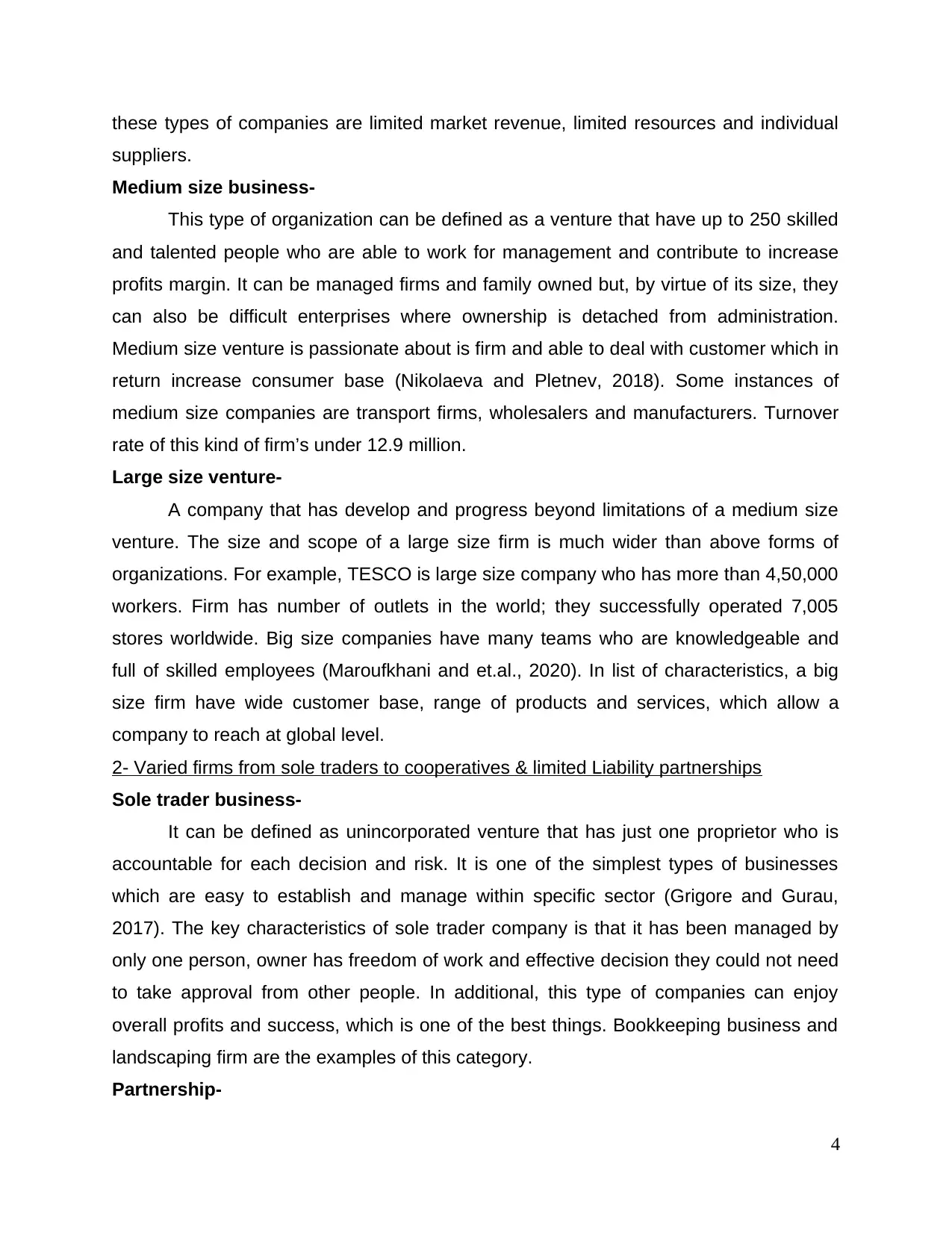
these types of companies are limited market revenue, limited resources and individual
suppliers.
Medium size business-
This type of organization can be defined as a venture that have up to 250 skilled
and talented people who are able to work for management and contribute to increase
profits margin. It can be managed firms and family owned but, by virtue of its size, they
can also be difficult enterprises where ownership is detached from administration.
Medium size venture is passionate about is firm and able to deal with customer which in
return increase consumer base (Nikolaeva and Pletnev, 2018). Some instances of
medium size companies are transport firms, wholesalers and manufacturers. Turnover
rate of this kind of firm’s under 12.9 million.
Large size venture-
A company that has develop and progress beyond limitations of a medium size
venture. The size and scope of a large size firm is much wider than above forms of
organizations. For example, TESCO is large size company who has more than 4,50,000
workers. Firm has number of outlets in the world; they successfully operated 7,005
stores worldwide. Big size companies have many teams who are knowledgeable and
full of skilled employees (Maroufkhani and et.al., 2020). In list of characteristics, a big
size firm have wide customer base, range of products and services, which allow a
company to reach at global level.
2- Varied firms from sole traders to cooperatives & limited Liability partnerships
Sole trader business-
It can be defined as unincorporated venture that has just one proprietor who is
accountable for each decision and risk. It is one of the simplest types of businesses
which are easy to establish and manage within specific sector (Grigore and Gurau,
2017). The key characteristics of sole trader company is that it has been managed by
only one person, owner has freedom of work and effective decision they could not need
to take approval from other people. In additional, this type of companies can enjoy
overall profits and success, which is one of the best things. Bookkeeping business and
landscaping firm are the examples of this category.
Partnership-
4
suppliers.
Medium size business-
This type of organization can be defined as a venture that have up to 250 skilled
and talented people who are able to work for management and contribute to increase
profits margin. It can be managed firms and family owned but, by virtue of its size, they
can also be difficult enterprises where ownership is detached from administration.
Medium size venture is passionate about is firm and able to deal with customer which in
return increase consumer base (Nikolaeva and Pletnev, 2018). Some instances of
medium size companies are transport firms, wholesalers and manufacturers. Turnover
rate of this kind of firm’s under 12.9 million.
Large size venture-
A company that has develop and progress beyond limitations of a medium size
venture. The size and scope of a large size firm is much wider than above forms of
organizations. For example, TESCO is large size company who has more than 4,50,000
workers. Firm has number of outlets in the world; they successfully operated 7,005
stores worldwide. Big size companies have many teams who are knowledgeable and
full of skilled employees (Maroufkhani and et.al., 2020). In list of characteristics, a big
size firm have wide customer base, range of products and services, which allow a
company to reach at global level.
2- Varied firms from sole traders to cooperatives & limited Liability partnerships
Sole trader business-
It can be defined as unincorporated venture that has just one proprietor who is
accountable for each decision and risk. It is one of the simplest types of businesses
which are easy to establish and manage within specific sector (Grigore and Gurau,
2017). The key characteristics of sole trader company is that it has been managed by
only one person, owner has freedom of work and effective decision they could not need
to take approval from other people. In additional, this type of companies can enjoy
overall profits and success, which is one of the best things. Bookkeeping business and
landscaping firm are the examples of this category.
Partnership-
4
Paraphrase This Document
Need a fresh take? Get an instant paraphrase of this document with our AI Paraphraser
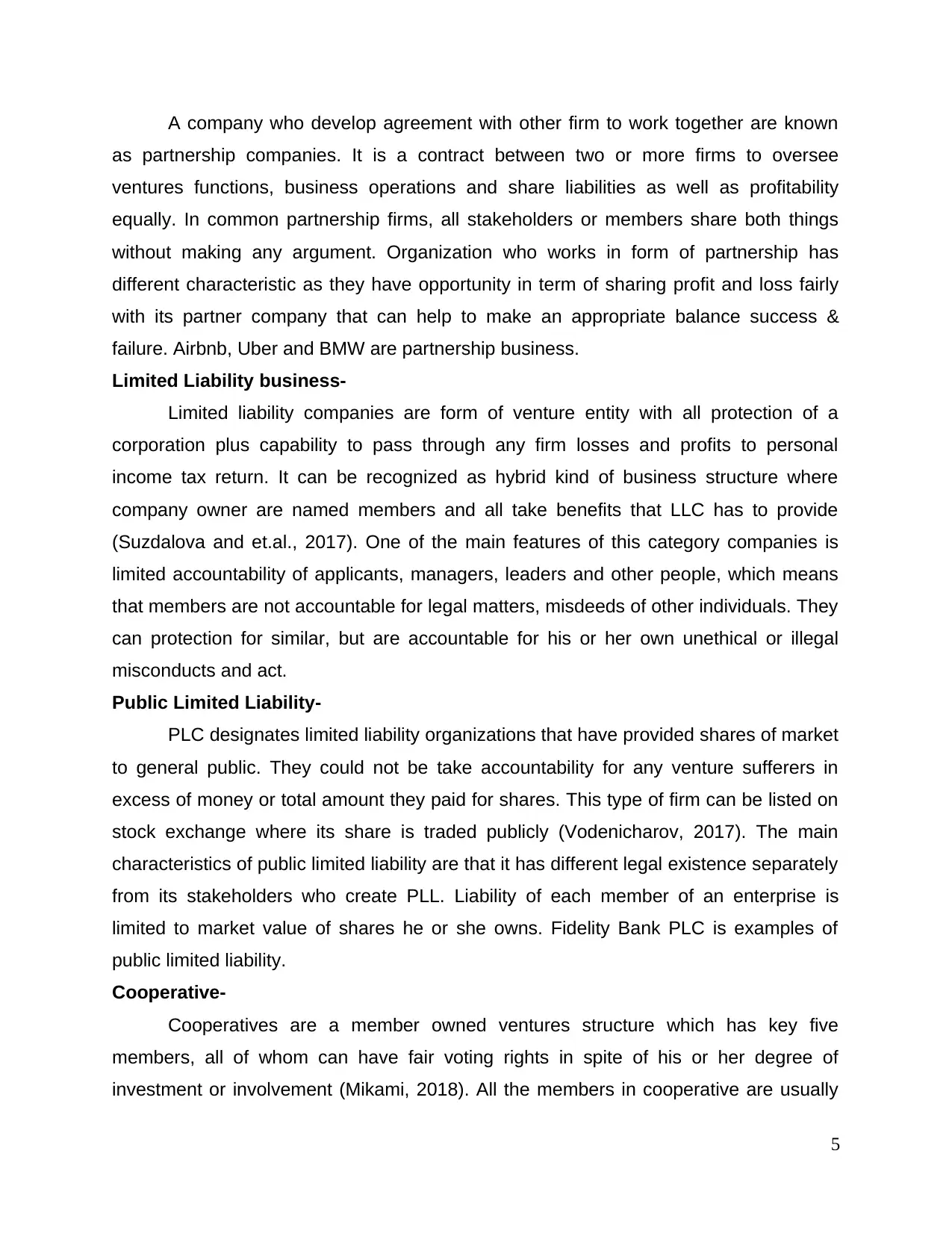
A company who develop agreement with other firm to work together are known
as partnership companies. It is a contract between two or more firms to oversee
ventures functions, business operations and share liabilities as well as profitability
equally. In common partnership firms, all stakeholders or members share both things
without making any argument. Organization who works in form of partnership has
different characteristic as they have opportunity in term of sharing profit and loss fairly
with its partner company that can help to make an appropriate balance success &
failure. Airbnb, Uber and BMW are partnership business.
Limited Liability business-
Limited liability companies are form of venture entity with all protection of a
corporation plus capability to pass through any firm losses and profits to personal
income tax return. It can be recognized as hybrid kind of business structure where
company owner are named members and all take benefits that LLC has to provide
(Suzdalova and et.al., 2017). One of the main features of this category companies is
limited accountability of applicants, managers, leaders and other people, which means
that members are not accountable for legal matters, misdeeds of other individuals. They
can protection for similar, but are accountable for his or her own unethical or illegal
misconducts and act.
Public Limited Liability-
PLC designates limited liability organizations that have provided shares of market
to general public. They could not be take accountability for any venture sufferers in
excess of money or total amount they paid for shares. This type of firm can be listed on
stock exchange where its share is traded publicly (Vodenicharov, 2017). The main
characteristics of public limited liability are that it has different legal existence separately
from its stakeholders who create PLL. Liability of each member of an enterprise is
limited to market value of shares he or she owns. Fidelity Bank PLC is examples of
public limited liability.
Cooperative-
Cooperatives are a member owned ventures structure which has key five
members, all of whom can have fair voting rights in spite of his or her degree of
investment or involvement (Mikami, 2018). All the members in cooperative are usually
5
as partnership companies. It is a contract between two or more firms to oversee
ventures functions, business operations and share liabilities as well as profitability
equally. In common partnership firms, all stakeholders or members share both things
without making any argument. Organization who works in form of partnership has
different characteristic as they have opportunity in term of sharing profit and loss fairly
with its partner company that can help to make an appropriate balance success &
failure. Airbnb, Uber and BMW are partnership business.
Limited Liability business-
Limited liability companies are form of venture entity with all protection of a
corporation plus capability to pass through any firm losses and profits to personal
income tax return. It can be recognized as hybrid kind of business structure where
company owner are named members and all take benefits that LLC has to provide
(Suzdalova and et.al., 2017). One of the main features of this category companies is
limited accountability of applicants, managers, leaders and other people, which means
that members are not accountable for legal matters, misdeeds of other individuals. They
can protection for similar, but are accountable for his or her own unethical or illegal
misconducts and act.
Public Limited Liability-
PLC designates limited liability organizations that have provided shares of market
to general public. They could not be take accountability for any venture sufferers in
excess of money or total amount they paid for shares. This type of firm can be listed on
stock exchange where its share is traded publicly (Vodenicharov, 2017). The main
characteristics of public limited liability are that it has different legal existence separately
from its stakeholders who create PLL. Liability of each member of an enterprise is
limited to market value of shares he or she owns. Fidelity Bank PLC is examples of
public limited liability.
Cooperative-
Cooperatives are a member owned ventures structure which has key five
members, all of whom can have fair voting rights in spite of his or her degree of
investment or involvement (Mikami, 2018). All the members in cooperative are usually
5
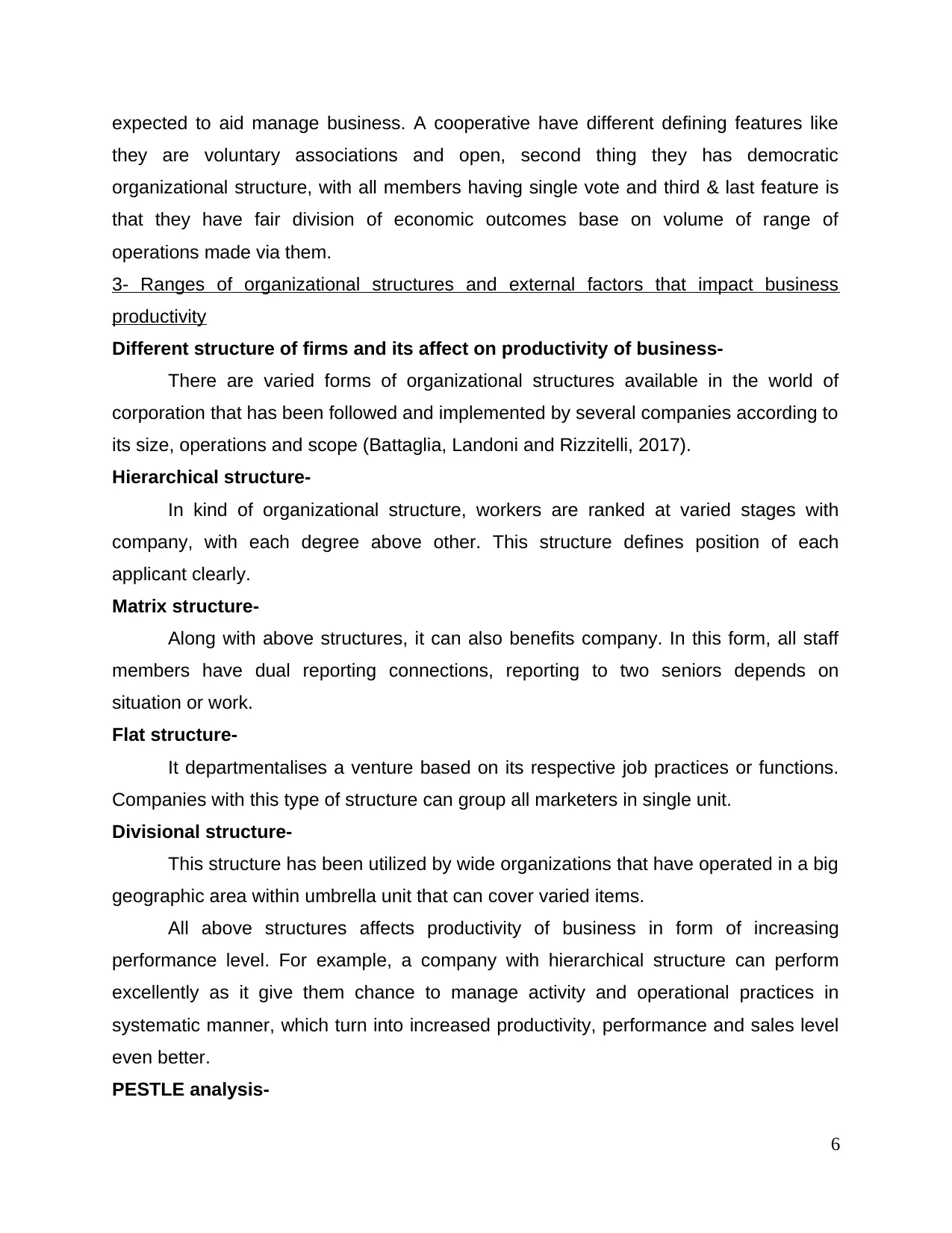
expected to aid manage business. A cooperative have different defining features like
they are voluntary associations and open, second thing they has democratic
organizational structure, with all members having single vote and third & last feature is
that they have fair division of economic outcomes base on volume of range of
operations made via them.
3- Ranges of organizational structures and external factors that impact business
productivity
Different structure of firms and its affect on productivity of business-
There are varied forms of organizational structures available in the world of
corporation that has been followed and implemented by several companies according to
its size, operations and scope (Battaglia, Landoni and Rizzitelli, 2017).
Hierarchical structure-
In kind of organizational structure, workers are ranked at varied stages with
company, with each degree above other. This structure defines position of each
applicant clearly.
Matrix structure-
Along with above structures, it can also benefits company. In this form, all staff
members have dual reporting connections, reporting to two seniors depends on
situation or work.
Flat structure-
It departmentalises a venture based on its respective job practices or functions.
Companies with this type of structure can group all marketers in single unit.
Divisional structure-
This structure has been utilized by wide organizations that have operated in a big
geographic area within umbrella unit that can cover varied items.
All above structures affects productivity of business in form of increasing
performance level. For example, a company with hierarchical structure can perform
excellently as it give them chance to manage activity and operational practices in
systematic manner, which turn into increased productivity, performance and sales level
even better.
PESTLE analysis-
6
they are voluntary associations and open, second thing they has democratic
organizational structure, with all members having single vote and third & last feature is
that they have fair division of economic outcomes base on volume of range of
operations made via them.
3- Ranges of organizational structures and external factors that impact business
productivity
Different structure of firms and its affect on productivity of business-
There are varied forms of organizational structures available in the world of
corporation that has been followed and implemented by several companies according to
its size, operations and scope (Battaglia, Landoni and Rizzitelli, 2017).
Hierarchical structure-
In kind of organizational structure, workers are ranked at varied stages with
company, with each degree above other. This structure defines position of each
applicant clearly.
Matrix structure-
Along with above structures, it can also benefits company. In this form, all staff
members have dual reporting connections, reporting to two seniors depends on
situation or work.
Flat structure-
It departmentalises a venture based on its respective job practices or functions.
Companies with this type of structure can group all marketers in single unit.
Divisional structure-
This structure has been utilized by wide organizations that have operated in a big
geographic area within umbrella unit that can cover varied items.
All above structures affects productivity of business in form of increasing
performance level. For example, a company with hierarchical structure can perform
excellently as it give them chance to manage activity and operational practices in
systematic manner, which turn into increased productivity, performance and sales level
even better.
PESTLE analysis-
6
⊘ This is a preview!⊘
Do you want full access?
Subscribe today to unlock all pages.

Trusted by 1+ million students worldwide
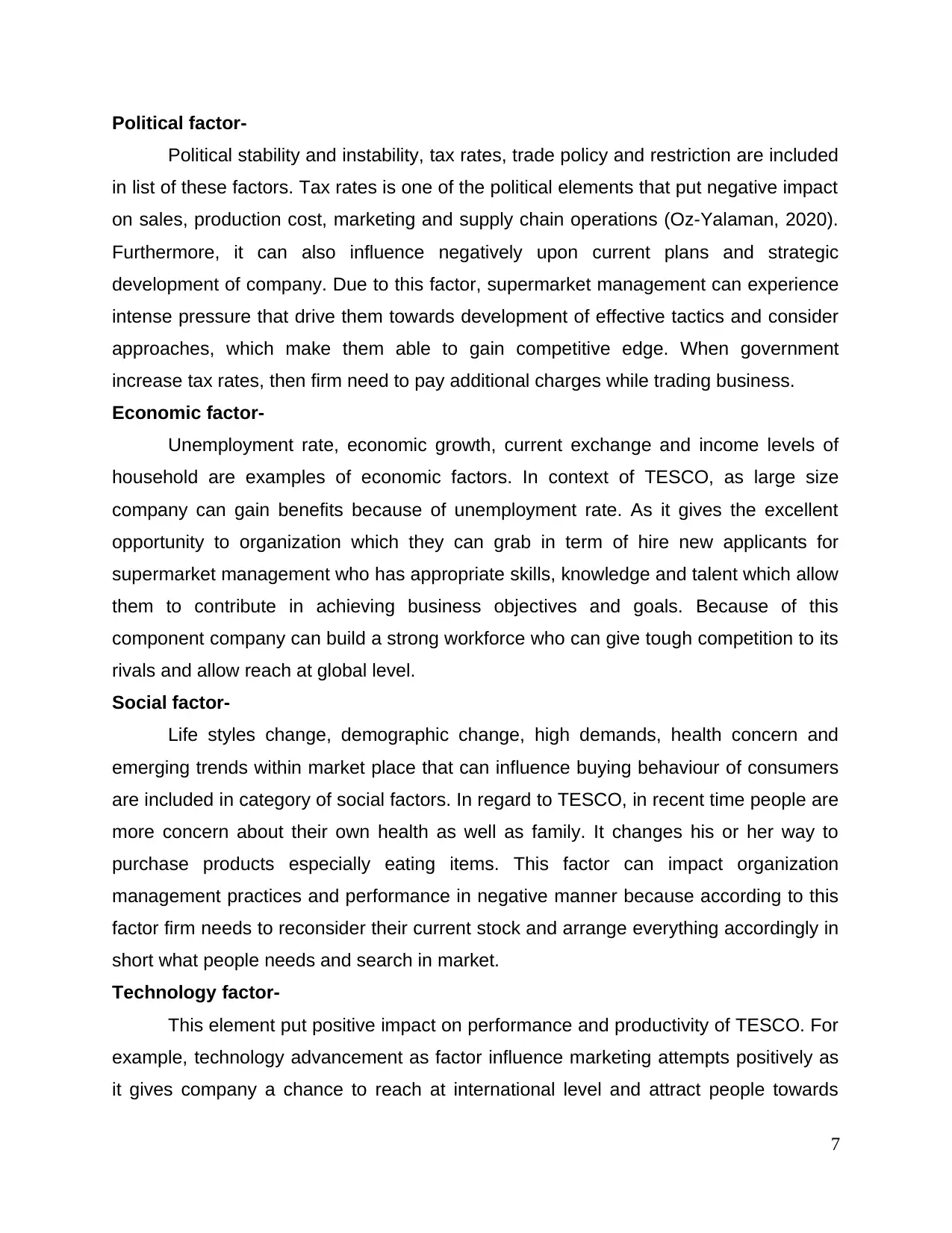
Political factor-
Political stability and instability, tax rates, trade policy and restriction are included
in list of these factors. Tax rates is one of the political elements that put negative impact
on sales, production cost, marketing and supply chain operations (Oz-Yalaman, 2020).
Furthermore, it can also influence negatively upon current plans and strategic
development of company. Due to this factor, supermarket management can experience
intense pressure that drive them towards development of effective tactics and consider
approaches, which make them able to gain competitive edge. When government
increase tax rates, then firm need to pay additional charges while trading business.
Economic factor-
Unemployment rate, economic growth, current exchange and income levels of
household are examples of economic factors. In context of TESCO, as large size
company can gain benefits because of unemployment rate. As it gives the excellent
opportunity to organization which they can grab in term of hire new applicants for
supermarket management who has appropriate skills, knowledge and talent which allow
them to contribute in achieving business objectives and goals. Because of this
component company can build a strong workforce who can give tough competition to its
rivals and allow reach at global level.
Social factor-
Life styles change, demographic change, high demands, health concern and
emerging trends within market place that can influence buying behaviour of consumers
are included in category of social factors. In regard to TESCO, in recent time people are
more concern about their own health as well as family. It changes his or her way to
purchase products especially eating items. This factor can impact organization
management practices and performance in negative manner because according to this
factor firm needs to reconsider their current stock and arrange everything accordingly in
short what people needs and search in market.
Technology factor-
This element put positive impact on performance and productivity of TESCO. For
example, technology advancement as factor influence marketing attempts positively as
it gives company a chance to reach at international level and attract people towards
7
Political stability and instability, tax rates, trade policy and restriction are included
in list of these factors. Tax rates is one of the political elements that put negative impact
on sales, production cost, marketing and supply chain operations (Oz-Yalaman, 2020).
Furthermore, it can also influence negatively upon current plans and strategic
development of company. Due to this factor, supermarket management can experience
intense pressure that drive them towards development of effective tactics and consider
approaches, which make them able to gain competitive edge. When government
increase tax rates, then firm need to pay additional charges while trading business.
Economic factor-
Unemployment rate, economic growth, current exchange and income levels of
household are examples of economic factors. In context of TESCO, as large size
company can gain benefits because of unemployment rate. As it gives the excellent
opportunity to organization which they can grab in term of hire new applicants for
supermarket management who has appropriate skills, knowledge and talent which allow
them to contribute in achieving business objectives and goals. Because of this
component company can build a strong workforce who can give tough competition to its
rivals and allow reach at global level.
Social factor-
Life styles change, demographic change, high demands, health concern and
emerging trends within market place that can influence buying behaviour of consumers
are included in category of social factors. In regard to TESCO, in recent time people are
more concern about their own health as well as family. It changes his or her way to
purchase products especially eating items. This factor can impact organization
management practices and performance in negative manner because according to this
factor firm needs to reconsider their current stock and arrange everything accordingly in
short what people needs and search in market.
Technology factor-
This element put positive impact on performance and productivity of TESCO. For
example, technology advancement as factor influence marketing attempts positively as
it gives company a chance to reach at international level and attract people towards
7
Paraphrase This Document
Need a fresh take? Get an instant paraphrase of this document with our AI Paraphraser
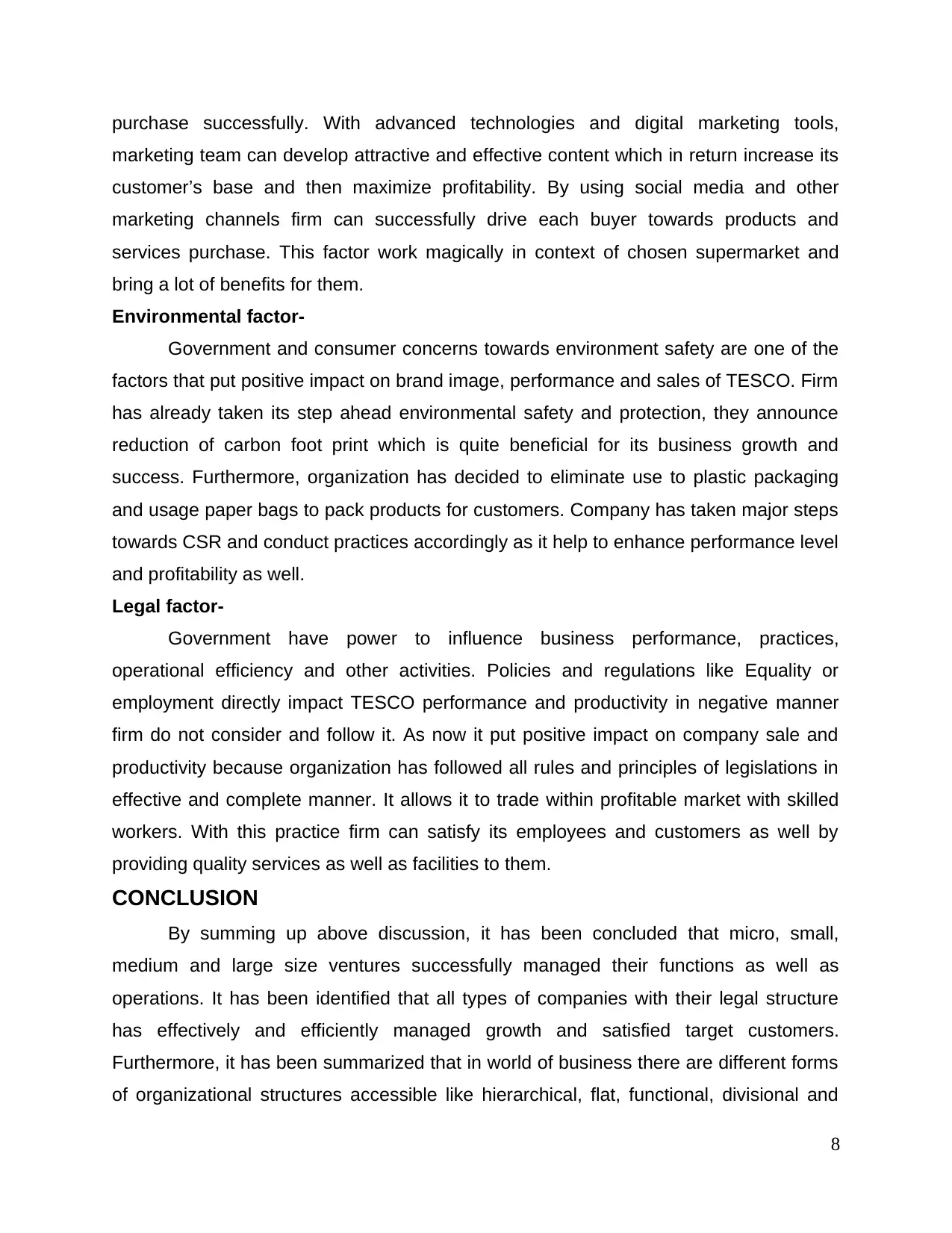
purchase successfully. With advanced technologies and digital marketing tools,
marketing team can develop attractive and effective content which in return increase its
customer’s base and then maximize profitability. By using social media and other
marketing channels firm can successfully drive each buyer towards products and
services purchase. This factor work magically in context of chosen supermarket and
bring a lot of benefits for them.
Environmental factor-
Government and consumer concerns towards environment safety are one of the
factors that put positive impact on brand image, performance and sales of TESCO. Firm
has already taken its step ahead environmental safety and protection, they announce
reduction of carbon foot print which is quite beneficial for its business growth and
success. Furthermore, organization has decided to eliminate use to plastic packaging
and usage paper bags to pack products for customers. Company has taken major steps
towards CSR and conduct practices accordingly as it help to enhance performance level
and profitability as well.
Legal factor-
Government have power to influence business performance, practices,
operational efficiency and other activities. Policies and regulations like Equality or
employment directly impact TESCO performance and productivity in negative manner
firm do not consider and follow it. As now it put positive impact on company sale and
productivity because organization has followed all rules and principles of legislations in
effective and complete manner. It allows it to trade within profitable market with skilled
workers. With this practice firm can satisfy its employees and customers as well by
providing quality services as well as facilities to them.
CONCLUSION
By summing up above discussion, it has been concluded that micro, small,
medium and large size ventures successfully managed their functions as well as
operations. It has been identified that all types of companies with their legal structure
has effectively and efficiently managed growth and satisfied target customers.
Furthermore, it has been summarized that in world of business there are different forms
of organizational structures accessible like hierarchical, flat, functional, divisional and
8
marketing team can develop attractive and effective content which in return increase its
customer’s base and then maximize profitability. By using social media and other
marketing channels firm can successfully drive each buyer towards products and
services purchase. This factor work magically in context of chosen supermarket and
bring a lot of benefits for them.
Environmental factor-
Government and consumer concerns towards environment safety are one of the
factors that put positive impact on brand image, performance and sales of TESCO. Firm
has already taken its step ahead environmental safety and protection, they announce
reduction of carbon foot print which is quite beneficial for its business growth and
success. Furthermore, organization has decided to eliminate use to plastic packaging
and usage paper bags to pack products for customers. Company has taken major steps
towards CSR and conduct practices accordingly as it help to enhance performance level
and profitability as well.
Legal factor-
Government have power to influence business performance, practices,
operational efficiency and other activities. Policies and regulations like Equality or
employment directly impact TESCO performance and productivity in negative manner
firm do not consider and follow it. As now it put positive impact on company sale and
productivity because organization has followed all rules and principles of legislations in
effective and complete manner. It allows it to trade within profitable market with skilled
workers. With this practice firm can satisfy its employees and customers as well by
providing quality services as well as facilities to them.
CONCLUSION
By summing up above discussion, it has been concluded that micro, small,
medium and large size ventures successfully managed their functions as well as
operations. It has been identified that all types of companies with their legal structure
has effectively and efficiently managed growth and satisfied target customers.
Furthermore, it has been summarized that in world of business there are different forms
of organizational structures accessible like hierarchical, flat, functional, divisional and
8
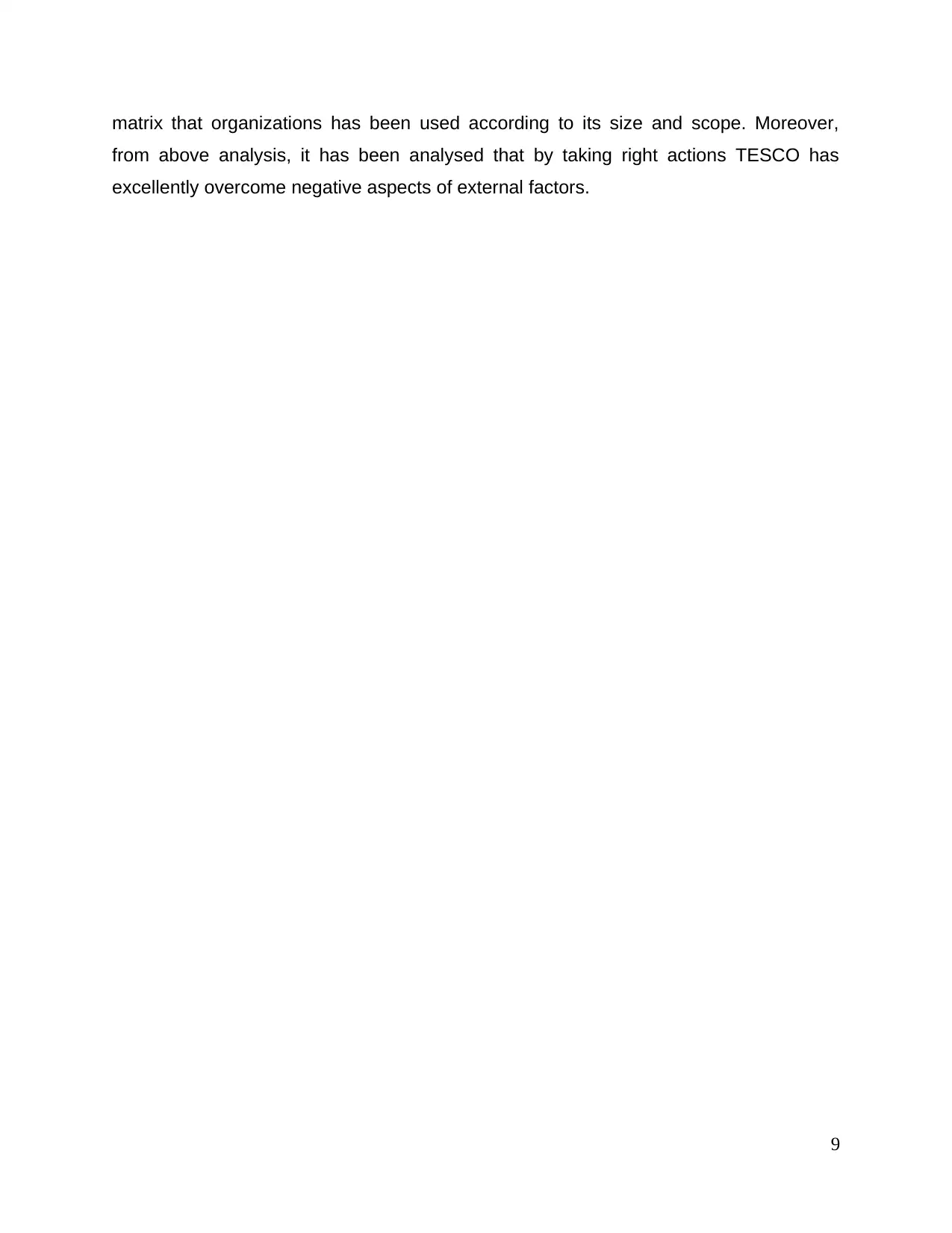
matrix that organizations has been used according to its size and scope. Moreover,
from above analysis, it has been analysed that by taking right actions TESCO has
excellently overcome negative aspects of external factors.
9
from above analysis, it has been analysed that by taking right actions TESCO has
excellently overcome negative aspects of external factors.
9
⊘ This is a preview!⊘
Do you want full access?
Subscribe today to unlock all pages.

Trusted by 1+ million students worldwide
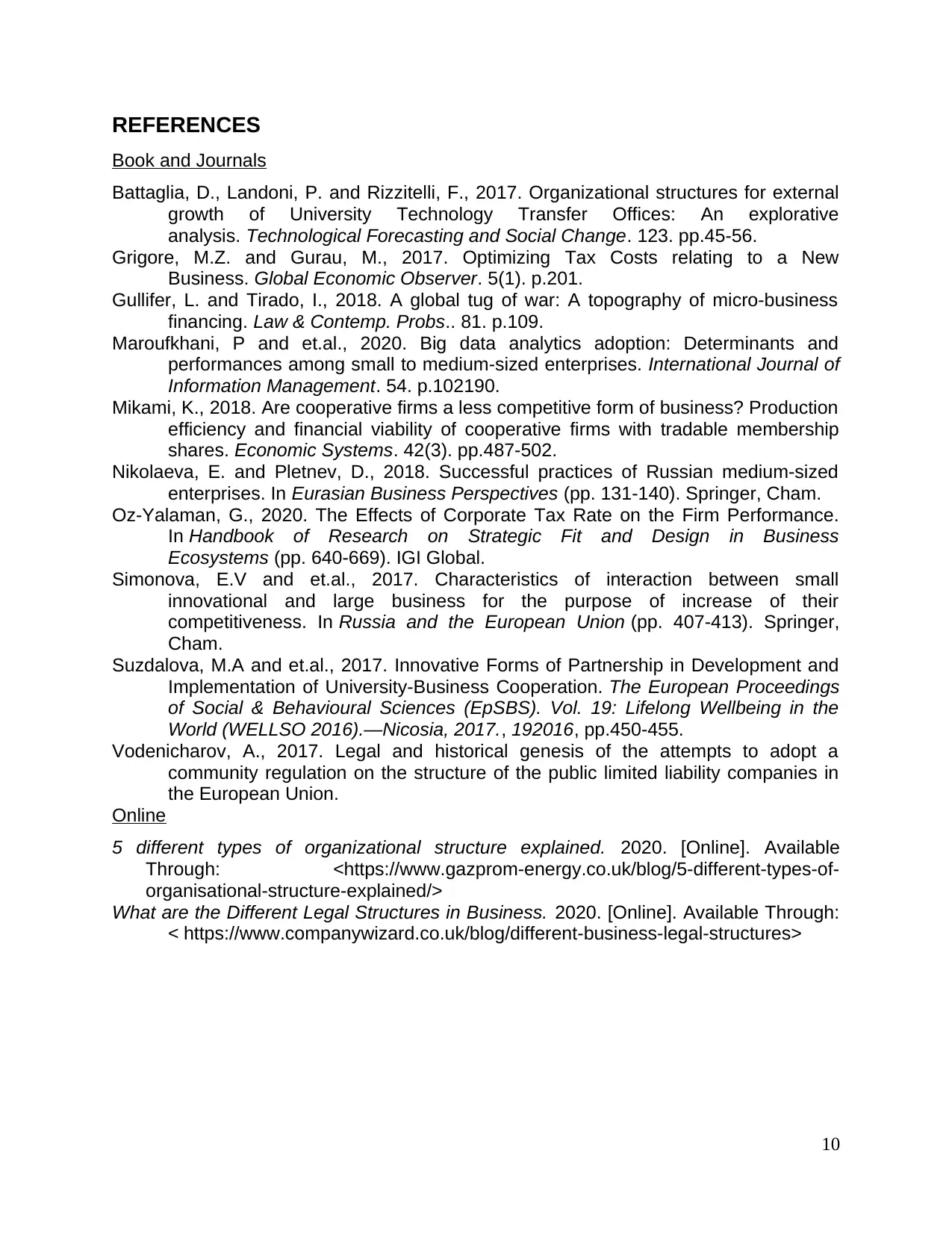
REFERENCES
Book and Journals
Battaglia, D., Landoni, P. and Rizzitelli, F., 2017. Organizational structures for external
growth of University Technology Transfer Offices: An explorative
analysis. Technological Forecasting and Social Change. 123. pp.45-56.
Grigore, M.Z. and Gurau, M., 2017. Optimizing Tax Costs relating to a New
Business. Global Economic Observer. 5(1). p.201.
Gullifer, L. and Tirado, I., 2018. A global tug of war: A topography of micro-business
financing. Law & Contemp. Probs.. 81. p.109.
Maroufkhani, P and et.al., 2020. Big data analytics adoption: Determinants and
performances among small to medium-sized enterprises. International Journal of
Information Management. 54. p.102190.
Mikami, K., 2018. Are cooperative firms a less competitive form of business? Production
efficiency and financial viability of cooperative firms with tradable membership
shares. Economic Systems. 42(3). pp.487-502.
Nikolaeva, E. and Pletnev, D., 2018. Successful practices of Russian medium-sized
enterprises. In Eurasian Business Perspectives (pp. 131-140). Springer, Cham.
Oz-Yalaman, G., 2020. The Effects of Corporate Tax Rate on the Firm Performance.
In Handbook of Research on Strategic Fit and Design in Business
Ecosystems (pp. 640-669). IGI Global.
Simonova, E.V and et.al., 2017. Characteristics of interaction between small
innovational and large business for the purpose of increase of their
competitiveness. In Russia and the European Union (pp. 407-413). Springer,
Cham.
Suzdalova, M.A and et.al., 2017. Innovative Forms of Partnership in Development and
Implementation of University-Business Cooperation. The European Proceedings
of Social & Behavioural Sciences (EpSBS). Vol. 19: Lifelong Wellbeing in the
World (WELLSO 2016).—Nicosia, 2017., 192016, pp.450-455.
Vodenicharov, A., 2017. Legal and historical genesis of the attempts to adopt a
community regulation on the structure of the public limited liability companies in
the European Union.
Online
5 different types of organizational structure explained. 2020. [Online]. Available
Through: <https://www.gazprom-energy.co.uk/blog/5-different-types-of-
organisational-structure-explained/>
What are the Different Legal Structures in Business. 2020. [Online]. Available Through:
< https://www.companywizard.co.uk/blog/different-business-legal-structures>
10
Book and Journals
Battaglia, D., Landoni, P. and Rizzitelli, F., 2017. Organizational structures for external
growth of University Technology Transfer Offices: An explorative
analysis. Technological Forecasting and Social Change. 123. pp.45-56.
Grigore, M.Z. and Gurau, M., 2017. Optimizing Tax Costs relating to a New
Business. Global Economic Observer. 5(1). p.201.
Gullifer, L. and Tirado, I., 2018. A global tug of war: A topography of micro-business
financing. Law & Contemp. Probs.. 81. p.109.
Maroufkhani, P and et.al., 2020. Big data analytics adoption: Determinants and
performances among small to medium-sized enterprises. International Journal of
Information Management. 54. p.102190.
Mikami, K., 2018. Are cooperative firms a less competitive form of business? Production
efficiency and financial viability of cooperative firms with tradable membership
shares. Economic Systems. 42(3). pp.487-502.
Nikolaeva, E. and Pletnev, D., 2018. Successful practices of Russian medium-sized
enterprises. In Eurasian Business Perspectives (pp. 131-140). Springer, Cham.
Oz-Yalaman, G., 2020. The Effects of Corporate Tax Rate on the Firm Performance.
In Handbook of Research on Strategic Fit and Design in Business
Ecosystems (pp. 640-669). IGI Global.
Simonova, E.V and et.al., 2017. Characteristics of interaction between small
innovational and large business for the purpose of increase of their
competitiveness. In Russia and the European Union (pp. 407-413). Springer,
Cham.
Suzdalova, M.A and et.al., 2017. Innovative Forms of Partnership in Development and
Implementation of University-Business Cooperation. The European Proceedings
of Social & Behavioural Sciences (EpSBS). Vol. 19: Lifelong Wellbeing in the
World (WELLSO 2016).—Nicosia, 2017., 192016, pp.450-455.
Vodenicharov, A., 2017. Legal and historical genesis of the attempts to adopt a
community regulation on the structure of the public limited liability companies in
the European Union.
Online
5 different types of organizational structure explained. 2020. [Online]. Available
Through: <https://www.gazprom-energy.co.uk/blog/5-different-types-of-
organisational-structure-explained/>
What are the Different Legal Structures in Business. 2020. [Online]. Available Through:
< https://www.companywizard.co.uk/blog/different-business-legal-structures>
10
1 out of 10
Related Documents
Your All-in-One AI-Powered Toolkit for Academic Success.
+13062052269
info@desklib.com
Available 24*7 on WhatsApp / Email
![[object Object]](/_next/static/media/star-bottom.7253800d.svg)
Unlock your academic potential
Copyright © 2020–2025 A2Z Services. All Rights Reserved. Developed and managed by ZUCOL.




